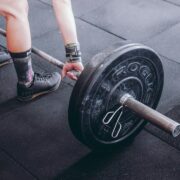
Bodyweight Mastery: Calisthenics Workouts for Ultimate Fitness
Bodyweight training, also known as calisthenics, is a form of exercise that uses the weight of your own body as resistance. It involves performing various movements and exercises that target different muscle groups, without the need for any equipment or weights. Calisthenics has been around for centuries and has its roots in ancient Greece, where it was used as a training method for soldiers and athletes.
The benefits of bodyweight training are numerous. Firstly, it improves flexibility and mobility by requiring you to move your body through a full range of motion. This can help to prevent injuries and improve overall movement quality. Secondly, bodyweight training increases strength and endurance. By consistently challenging your muscles with bodyweight exercises, you can build lean muscle mass and improve your overall fitness level. Lastly, bodyweight training can enhance body composition by helping you to burn fat and build muscle simultaneously.
Key Takeaways
- Bodyweight mastery and calisthenics workouts are a great way to improve fitness without needing equipment or a gym membership.
- Benefits of bodyweight training include improved strength, endurance, flexibility, and balance, as well as reduced risk of injury.
- Push-ups, pull-ups, and squats are essential exercises for building strength and mastering the basics of calisthenics.
- Advanced calisthenics techniques, such as muscle-ups and handstands, can provide a challenging workout for those looking to take their fitness to the next level.
- Developing a full-body workout routine with bodyweight exercises can be done by targeting different muscle groups and incorporating progressions and variations.
Benefits of Bodyweight Training for Ultimate Fitness
One of the key benefits of bodyweight training is improved flexibility and mobility. Many bodyweight exercises require you to move your body through a full range of motion, which helps to increase joint mobility and flexibility. This can be especially beneficial for individuals who have tight muscles or limited range of motion in certain areas of their body. By regularly practicing bodyweight exercises, you can improve your overall flexibility and mobility, which can help to prevent injuries and improve your performance in other activities.
Another benefit of bodyweight training is increased strength and endurance. Bodyweight exercises are highly effective at building strength because they require you to move your own body weight against gravity. This means that you are constantly challenging your muscles to work harder and become stronger. Additionally, bodyweight exercises can also improve your muscular endurance, as they often involve performing multiple repetitions or holding positions for an extended period of time.
In addition to improving flexibility, mobility, strength, and endurance, bodyweight training can also enhance body composition. By regularly engaging in bodyweight exercises, you can burn calories and build lean muscle mass. This can help to increase your metabolism and improve your overall body composition. Additionally, bodyweight exercises can be modified to increase the intensity and challenge your muscles even further, which can help to accelerate fat loss and muscle gain.
Building Strength and Endurance with Calisthenics Exercises
When it comes to building strength and endurance with calisthenics exercises, progressive overload is key. Progressive overload refers to gradually increasing the demands placed on your muscles over time in order to continue making progress. This can be achieved by increasing the number of repetitions, sets, or difficulty of the exercises you perform.
There are numerous calisthenics exercises that can help you build strength and endurance. Some examples include push-ups, pull-ups, squats, lunges, planks, and burpees. These exercises target multiple muscle groups and can be modified to suit your fitness level. For example, if you are a beginner, you can start with modified push-ups or assisted pull-ups using a resistance band. As you become stronger, you can progress to more challenging variations such as one-arm push-ups or strict pull-ups.
Tracking your progress is important in order to ensure that you are continually challenging yourself and making progress. This can be done by keeping a workout journal or using a fitness app that allows you to record your workouts and track your performance over time. By regularly monitoring your progress, you can identify areas where you need to improve and make adjustments to your training program accordingly.
Mastering the Basics: Push-ups, Pull-ups, and Squats
| Exercise | Repetitions | Sets | Rest Time | Difficulty Level |
|---|---|---|---|---|
| Push-ups | 10-20 | 3-5 | 30-60 seconds | Beginner to Intermediate |
| Pull-ups | 5-10 | 3-5 | 30-60 seconds | Intermediate to Advanced |
| Squats | 10-20 | 3-5 | 30-60 seconds | Beginner to Intermediate |
Push-ups, pull-ups, and squats are three fundamental bodyweight exercises that form the foundation of any calisthenics training program. Mastering these exercises is essential for building strength and developing a solid base for more advanced movements.
Proper form and technique are crucial when performing push-ups, pull-ups, and squats. For push-ups, start in a high plank position with your hands slightly wider than shoulder-width apart. Lower your body until your chest touches the ground, then push back up to the starting position. Keep your core engaged and maintain a straight line from your head to your heels throughout the movement.
Pull-ups are performed by hanging from a bar with an overhand grip, hands slightly wider than shoulder-width apart. Pull your body up until your chin is above the bar, then lower yourself back down with control. Keep your core engaged and avoid swinging or using momentum to complete the movement.
Squats are performed by standing with your feet shoulder-width apart, toes slightly turned out. Lower your body down as if sitting back into a chair, keeping your chest up and knees tracking over your toes. Go as low as you can while maintaining proper form, then push through your heels to return to the starting position.
Variations and progressions for each exercise can be used to increase the difficulty and continue challenging your muscles. For push-ups, you can try incline or decline variations, or even one-arm push-ups once you have built enough strength. For pull-ups, you can use resistance bands for assistance or try different grip variations such as chin-ups or wide-grip pull-ups. Squats can be made more challenging by adding weight or trying pistol squats, which involve balancing on one leg while performing the movement.
Incorporating these exercises into a workout routine is relatively simple. You can start with a basic full-body routine that includes push-ups, pull-ups, squats, and other compound movements such as lunges and planks. Aim to perform each exercise for 3-4 sets of 8-12 repetitions, resting for 60-90 seconds between sets. As you become stronger and more comfortable with the exercises, you can increase the intensity by adding more sets, repetitions, or difficulty.
Advanced Calisthenics Techniques for Challenging Workouts
Once you have mastered the basics of bodyweight training, you can progress to more advanced calisthenics exercises to further challenge your muscles and continue making progress. These exercises require a high level of strength, stability, and body control, and can help you take your fitness to the next level.
Some examples of advanced calisthenics exercises include muscle-ups, handstand push-ups, pistol squats, front levers, and planche push-ups. These exercises require a combination of strength, balance, and coordination, and often involve complex movements that target multiple muscle groups.
Progressing to advanced exercises should be done gradually and with caution. It is important to have a solid foundation of strength and proper form before attempting these movements. Start by incorporating progressions and variations of the advanced exercises into your routine to build the necessary strength and stability. For example, if you want to work towards a muscle-up, you can start by practicing pull-ups with an explosive movement at the top to mimic the transition from a pull-up to a dip.
Proper form and technique are crucial when performing advanced calisthenics exercises. These movements often require strict form and precise body positioning in order to be executed correctly and safely. It is important to focus on maintaining proper alignment and engaging the correct muscles throughout each movement. If you are unsure about proper form or technique, it is recommended to seek guidance from a qualified trainer or coach.
Developing a Full-Body Workout Routine with Bodyweight Exercises
Developing a balanced workout routine with bodyweight exercises is essential for maximizing your results and preventing imbalances or overuse injuries. A well-rounded routine should include exercises that target all major muscle groups and incorporate both strength training and cardiovascular conditioning.
To create a balanced workout routine, start by identifying your goals and determining how many days per week you can commit to training. Aim to include exercises that target your upper body, lower body, and core in each workout. For example, you can perform push-ups, pull-ups, and dips for your upper body, squats and lunges for your lower body, and planks and Russian twists for your core.
Sample workout routines for beginners could include a full-body routine performed 2-3 times per week. Each workout could consist of 3-4 sets of 8-12 repetitions of push-ups, pull-ups, squats, lunges, planks, and other compound movements. Rest for 60-90 seconds between sets and aim to complete the workout in 45-60 minutes.
Advanced trainees can follow a similar structure but increase the intensity by adding more sets, repetitions, or difficulty. They can also incorporate more advanced exercises or variations into their routine to continue challenging their muscles. For example, they can include muscle-ups, handstand push-ups, pistol squats, or front levers into their workouts.
Rest and recovery are important components of any workout routine. It is recommended to take at least one or two rest days per week to allow your muscles to recover and repair. Additionally, incorporating stretching or mobility exercises into your routine can help to improve flexibility and prevent muscle imbalances.
Combining Cardio and Calisthenics for Maximum Results
Combining cardio exercises with calisthenics can help to maximize your results and improve your overall fitness level. Cardiovascular conditioning is important for improving endurance, burning calories, and maintaining a healthy heart.
There are many ways to incorporate cardio exercises into your calisthenics routine. You can perform high-intensity interval training (HIIT) workouts that alternate between periods of intense exercise and short rest periods. This can be done by incorporating exercises such as burpees, mountain climbers, or jumping jacks into your routine.
Another option is to perform cardio exercises in between sets of strength exercises. For example, you can do a set of push-ups followed by a minute of jumping rope or running in place. This can help to keep your heart rate elevated and increase the overall intensity of your workout.
Structuring a workout for maximum results can be done by alternating between strength exercises and cardio exercises, or by incorporating circuit training. Circuit training involves performing a series of exercises back-to-back with little to no rest in between. This can help to improve cardiovascular fitness, burn calories, and challenge your muscles in a different way.
Overcoming Plateaus and Achieving Progress with Bodyweight Mastery
Plateaus are common in any training program, including bodyweight training. A plateau occurs when your progress stalls and you are no longer seeing improvements in strength or performance. This can be frustrating, but it is important to remember that plateaus are a normal part of the training process.
To overcome plateaus and continue making progress, it is important to make adjustments to your training program. This can include increasing the intensity or difficulty of your exercises, changing the order or sequence of your workouts, or incorporating new exercises or variations into your routine.
Consistency and patience are key when it comes to bodyweight mastery. Results take time and it is important to stay committed to your training program even when progress seems slow. It is also important to listen to your body and give yourself adequate rest and recovery time. Pushing through fatigue or overtraining can lead to injuries and hinder your progress.
Injury Prevention and Proper Form in Calisthenics Training
Injury prevention is crucial when it comes to calisthenics training. Common injuries in calisthenics include strains, sprains, tendonitis, and overuse injuries. These injuries can be prevented by following proper form and technique, listening to your body, and gradually progressing your exercises.
Proper form and technique are essential for preventing injuries in calisthenics. It is important to focus on maintaining proper alignment and engaging the correct muscles throughout each movement. If you are unsure about proper form or technique, it is recommended to seek guidance from a qualified trainer or coach.
Listening to your body is also important for injury prevention. If you experience pain or discomfort during an exercise, it is important to stop and assess the situation. Pushing through pain can lead to further injury and hinder your progress. It is also important to give yourself adequate rest and recovery time to allow your muscles to repair and rebuild.
Gradually progressing your exercises is key for injury prevention. It is important to start with exercises that match your current fitness level and gradually increase the difficulty or intensity over time. This allows your muscles and connective tissues to adapt and become stronger, reducing the risk of injury.
Incorporating Nutrition and Recovery into Your Bodyweight Mastery Journey
Incorporating nutrition and recovery into your bodyweight mastery journey is essential for optimal performance and results. Proper nutrition provides the fuel your body needs to perform at its best, while recovery allows your muscles to repair and rebuild.
Nutrition plays a crucial role in bodyweight training. It is important to fuel your body with a balanced diet that includes an adequate amount of protein, carbohydrates, and healthy fats. Protein is essential for muscle repair and growth, while carbohydrates provide energy for your workouts. Healthy fats are important for hormone production and overall health.
In addition to proper nutrition, recovery is also important for optimal performance. This includes getting enough sleep, staying hydrated, and incorporating rest days into your training program. Sleep allows your body to repair and regenerate, while hydration helps to maintain proper muscle function and prevent cramps or fatigue.
Tips for recovery and injury prevention include incorporating stretching or mobility exercises into your routine, using foam rollers or massage tools to release tension in your muscles, and practicing stress management techniques such as meditation or deep breathing exercises.
Bodyweight training and calisthenics offer numerous benefits for ultimate fitness. They improve flexibility and mobility, increase strength and endurance, enhance body composition, and reduce the risk of injury. By incorporating bodyweight exercises into your routine, you can build a strong and functional physique without the need for any equipment or weights.
Mastering the basics of bodyweight training, such as push-ups, pull-ups, and squats, is essential for building strength and developing a solid foundation. As you become more advanced, you can progress to more challenging exercises and techniques to continue challenging your muscles and making progress.
Developing a balanced workout routine that includes both strength training and cardiovascular conditioning is important for maximizing your results. Combining cardio exercises with calisthenics can help to improve endurance, burn calories, and maintain a healthy heart.
Overcoming plateaus and achieving progress requires consistency, patience, and making adjustments to your training program. It is important to listen to your body, give yourself adequate rest and recovery time, and gradually progress your exercises.
Injury prevention is crucial in calisthenics training. Proper form and technique, listening to your body, and gradually progressing your exercises can help to prevent injuries and keep you safe.
Incorporating nutrition and recovery into your bodyweight mastery journey is essential for optimal performance. Proper nutrition provides the fuel your body needs to perform at its best, while recovery allows your muscles to repair and rebuild after intense workouts. Without proper nutrition, your body may not have enough energy to complete workouts or recover effectively. It is important to consume a balanced diet that includes carbohydrates, proteins, and healthy fats to support muscle growth and repair. Additionally, staying hydrated is crucial for maintaining optimal performance and aiding in recovery. Alongside nutrition, incorporating rest days and adequate sleep into your routine is essential for allowing your muscles to recover and prevent overtraining. Taking the time to prioritize both nutrition and recovery will help you maximize your bodyweight mastery journey and achieve your fitness goals.
FAQs
What are calisthenics workouts?
Calisthenics workouts are exercises that use bodyweight movements to build strength, flexibility, and endurance. These exercises include push-ups, pull-ups, squats, lunges, and other movements that use your own body weight as resistance.
What are the benefits of calisthenics workouts?
Calisthenics workouts can help you build strength, improve flexibility, and increase endurance. They can also help you burn fat and build muscle, and they require little to no equipment, making them a convenient and cost-effective way to exercise.
What are some examples of calisthenics exercises?
Some examples of calisthenics exercises include push-ups, pull-ups, squats, lunges, planks, burpees, and jumping jacks. These exercises can be modified to suit your fitness level and can be combined into a full-body workout.
Can calisthenics workouts help me lose weight?
Yes, calisthenics workouts can help you lose weight by burning calories and building muscle. However, weight loss also depends on your diet and overall lifestyle habits.
Do I need any equipment to do calisthenics workouts?
No, you do not need any equipment to do calisthenics workouts. However, some exercises may require a pull-up bar or other equipment, but these can often be found in public parks or purchased for home use.
Can calisthenics workouts help me build muscle?
Yes, calisthenics workouts can help you build muscle by using your own body weight as resistance. However, building muscle also depends on your diet and overall lifestyle habits.
Are calisthenics workouts suitable for beginners?
Yes, calisthenics workouts can be modified to suit beginners by using easier variations of exercises and gradually increasing intensity. It is important to start slowly and focus on proper form to avoid injury.


















